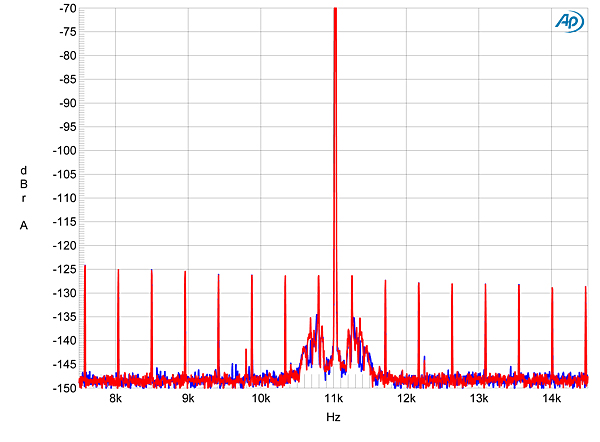| Columns Retired Columns & Blogs |
"...consistently delivering open highs, rich midrange timbres, a stunning dynamic range, and three-dimensional imaging."
You must be referring to the DAC!
I examined the measured behavior of the Bryston BDP-1 using the Audio Precision SYS2722 system (see www.ap.com and "As We See It" in the January 2008 issue), as well as the Miller Audio Research Jitter Analyzer. I played test tones, at various sample rates and bit depths, that I'd copied to a USB memory stick and plugged into one of the BDP-1's two front-panel USB ports. For the analog-domain jitter measurements (footnote 1), I fed the BDP-1's AES/EBU data output to our original review sample of the Bryston BDA-1 D/A processor (serial number 00100) via the 2' Hosa AES/EBU datalink LG had used for his review. (This datalink uses high-quality, 110-ohm Belden cable.)
I used the BDP-1's front-panel controls to navigate the audio files stored on the USB stick. Their use was intuitive. The BDP-1 successfully played files in the following formats (all I had available): WAV, AIFF, Apple Lossless, AAC (both self-ripped and purchased from iTunes), and MP3. It correctly handled data with sample rates ranging from 32kHz to 192kHz. Most important, its data output was bit-accurate, and the active bits in its digital output followed the bit depth of the file being played, 16 or 24.
The primary test for a product whose output is a serial datastream is the timing accuracy of that datastream. (While the master clock may have very low timing error, factors such as the impedance of the transmitter and the bandwidth of the datalink will increase jitter.) The BDP-1's AES/EBU output produced a very clean eye pattern (fig.1), with very little timing uncertainty at the beginning and end of the unit-sample waveform when tested with 16-bit J-Test data. The Audio Precision calculated the jitter level to be 637 picoseconds peak (measured with a 50Hz–100kHz bandwidth), which is relatively low.

Feeding the 16-bit J-Test data to the BDA-1 and performing an FFT analysis on the D/A processor's analog output produced the spectrum shown in fig.2. There is very slight accentuation of the primary sidebands around the central spike that represents the 11.025kHz tone at ±229.6875Hz—the Miller Analyzer calculated the level to be just 110ps peak–peak, which is at the limit of its resolution—and all the other sidebands visible in this graph are actually the residual odd-order harmonics of the low-frequency squarewave.

Very low-level sidebands are visible at ±250Hz in fig.2, as well as some modulation of the BDA-1's noise floor in the same regions. Repeating the spectral analysis with 24-bit data (fig.3) made the picture clearer, as now the data-related components are eliminated. Three sideband pairs are visible, at ±240, ±360, and ±1240Hz. I don't know from where these arise, but their levels are so low that I can confidently predict that they will have no audible consequences. The lower-frequency noise-floor modulation disappeared when I repeated the 24-bit J-Test using the SYS2722 as the data source (fig.4), but some higher-frequency modulation is now visible. Though this is higher in level in the right channel (red trace) than the left (blue), I suspect this behavior is still academic.


Bryston's BDP-1 proved to be an excellent-performing digital source, with a low-jitter, bit-accurate data output capable of operating at sample rates up to 192kHz. It is a natural partner for the company's BDA-1 D/A processor.—John Atkinson

"...consistently delivering open highs, rich midrange timbres, a stunning dynamic range, and three-dimensional imaging."
You must be referring to the DAC!